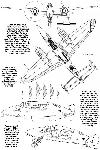
Варианты
- Sud-Est - SE.100 - 1939 - Франция
- Liore et Olivier - LeO 48 - 1941 - Франция
Sud-Est (SNCASE). Ранние самолеты
Национализация авиапромышленности Франции в 1936 году привела к образованию компании "Societe Nationale de Constructions Aeronautiques de Sud-Est". SNCASE ("Sud-Est"), которая объединила фирмы "Chantiers Aero-Maritime de la Seine", "Liore-et-Olivier", "Potez", "Romano" и "Societe Provencale des Constructions Aeronautiques".
Некоторые программы, начатые фирмами индивидуально, были продолжены после объединения. В том числе проектирование трехместного истребителя Liore-et-Olivier LeO 50 с двумя моторами Gnome-Rhone. Под обозначением Sud-Est S.E.100 построили два прототипа. Уникальной особенностью самолета являлось убираемое шасси с носовой опорой, дополнительная небольшая четвертая опора находилась в хвостовой части.
Первый прототип выполнил первый полет 29 марта 1939 года, но в апреле 1940 года разбился. Второй прототип не сделал ни одного полета, а запуск в серию не состоялся из-за оккупации Германией Франции.
<...>
- Описание
Фотографии
-
Aviation Historian 13 / N.Stroud - RumPunch
S.E.100 - уникальный трехместный истребитель, основные опоры которого убирались в кили.
The SE.100-01 prototype is prepared for flight during trials at Villacoublay in the spring of 1939. The distinctive triangular hatch in the rear fuselage provided access into a corridor which led to the cockpit.
Ailerons don’t come stranger than Mercier - both in principle and in practice on the SNCASE SE.100. -
Aviation Historian 13 / N.Stroud - RumPunch
The state-of-the-art SE.100 incorporated numerous ultra-modern features, including counter-rotating propellers - still uncommon in the late 1930s - for easier handling.
-
Aviation Historian 13 / N.Stroud - RumPunch
The prototype at Villacoublay, to where it was transported from Argenteuil for flight testing. It was intended that the somewhat over-engineered and unexpectedly fragile nosewheel would be replaced with a simpler mechanism on production aircraft.
-
Aviation Historian 13 / N.Stroud - RumPunch
Displaying its minimal frontal area - and resembling the USA’s late-war-vintage Grumman F7F Tigercat naval fighter - the prototype SE.100 has its Gnome-Rhone 14N engines run up during trials. Note the highly unusual arrangement in which the mainwheels retract into the twin fins.
-
Aviation Historian 13 / N.Stroud - RumPunch
Running up the engines at Villacoublay; the prototype underwent numerous changes during its early flight-test programme, including engine changes and the fitting of various propeller units.
-
Aviation Historian 13 / N.Stroud - RumPunch
A poor-quality but rare photograph of the SE.100 in flight. It is seen here on finals into Villacoublay, with undercarriage and generous flaps lowered.
-
Aviation Historian 13 / N.Stroud - RumPunch
Groundcrew prepare the prototype for a test flight at Villacoublay, from where the aircraft made 33 flights, all in the hands of Louis Rouland, between March and December 1939.
-
Aviation Historian 13 / N.Stroud - RumPunch
On December 9, 1939, the SE.100 prototype was flown to Marignane, near Marseille in the south of France, where it was put into a camouflage colour scheme. The canopy and wings were modified and the aircraft restarted its flight test programme on January 4, 1940.
-
Aviation Historian 13 / N.Stroud - RumPunch
During January-April 1940 the SE.100 was extensively tested at Marignane. At the end of March the engines were swapped to counter-rotate outboard, as opposed to inboard, as had been the case to that point. Sadly, Louis Rouland and mechanic Andre Vuagnoux were killed when the aircraft crashed near Crau on April 5, 1940.
-
Aviation Historian 13 / N.Stroud - RumPunch
This view of the prototype SE.100 in the SNCASE workshop at Argenteuil, undergoing final modifications to the hydraulic system, emphasises the type’s banana-shaped fuselage. Mercier’s design very much lived up to the specification of a thoroughly modern fighting aircraft, but its complex curves made it challenging to build.
-
Aviation Historian 13 / N.Stroud - RumPunch
The sharply curved rear fuselage of the SE.100 incorporated a channel in which the barrel of the 20mm Hispano-Suiza HS.404 cannon could be accommodated when not in use. The photograph on the right shows the cannon and gun position when extended.
-
Aviation Historian 13 / N.Stroud - RumPunch
The SE.100 was designed to be constructed from non-strategic materials as much as possible, with a metal frame providing the skeleton for a specially designed rigid plywood skin arranged in easily demountable panels for easy access.
-
Aviation Historian 13 / N.Stroud - RumPunch
The view from the SE.100’s cockpit was good in all aspects, the pilot being seated high and far forward of the wing’s leading edge. The layout of the instruments was busy but no more so than in any of the type’s contemporaries; indeed, Mercier and Lecarme were early advocates of ergonomic design.
-
Air International 1985-04 / Plane facts
The general arrangement drawing depicting the prototype in its definitive form.
-
Air International 1993-11 / Fighter A to Z
The Sud-Est SE 100 was a singularly innovative two/three-seat day and night fighter, for the production of which Citroen was tooling up in 1939.
- Фотографии















